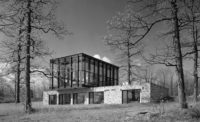|
It could be paying heed to the current economic crisis. It could be following President Obama’s lead in tackling tough social problems. And it might feel emboldened by recent federal legislation that architects lobbied for: the 21st Century Green High-Performing Public School Facilities Act, which calls for grants to be made available to public school systems for facility upgrades, and the $787 billion American Recovery and Reinvestment Act, which contains a range of promising construction projects.
The “it” is the American Institute of Architects (AIA), and its recent election of new officers reflects a heightened commitment to job security, social justice, and government work. Those officers were picked by 486 delegates representing local AIA chapters on Friday, May 1, in San Francisco, at the association’s annual convention. AIA rules stipulate that vote totals not be disclosed.
Clark Manus, FAIA, chief executive of Heller Manus Architects in San Francisco, will become the AIA’s 87th president in 2011. A top priority for him is to encourage architecture students to develop “broader skill sets,” particularly in business administration, to brace for the challenging job market. Manus, who is a current AIA vice president, also seeks to enrich the “Economy Resources” section of the AIA’s Web site with more career tips, workshop offerings, and job listings.
Building more middle-income city housing is another goal for Manus, who was a key advocate for adding a denser concentration of homes to the Rincon Hill and Transbay neighborhoods of San Francisco after its 1989 earthquake. Backing for projects of this type could come from President Obama’s newly created Office of Urban Affairs, which might help push long-neglected city-specific concerns to the forefront.
“I go back to my ’60s isms,” says Manus, 56, who beat out architect Mike Rodriguez, AIA, of Coral Gables, Florida, for the number-one spot. “If you are not part of the solution, you are part of the problem.”
The two 2011 vice-president positions, meanwhile, will be filled by Mickey Jacob, FAIA, managing principal of Urban Studio Architects, of Tampa, Florida, and Peter Kuttner, FAIA, president of Cambridge Seven Associates of Massachusetts. And the treasurer job will go to John Rogers, a partner at GBBN Architects, based in Cincinnati.
Like Manus, Jacob seems eager to roll up his sleeves in an attempt to get architects more involved with campaigns of local candidates who support sustainable development, among other issues, he says. This involvement could take the form of volunteering to work the phones in campaign offices or endorsing the politicians in letters to the editors of local newspapers.
If this grassroots activism were to come from AIA’s associate members—practicing architects who aren’t licensed, and who last year comprised 22 percent of the organization—all the better, he says.
“We’ve had better relations with lawmakers in the past few years,” Jacob says, “and now is time to build on that momentum.”






Post a comment to this article
Report Abusive Comment